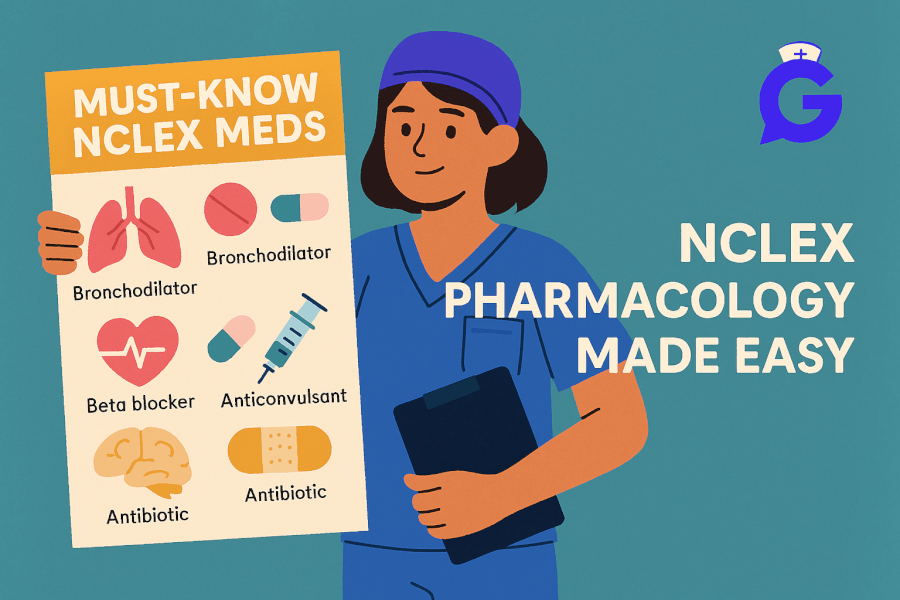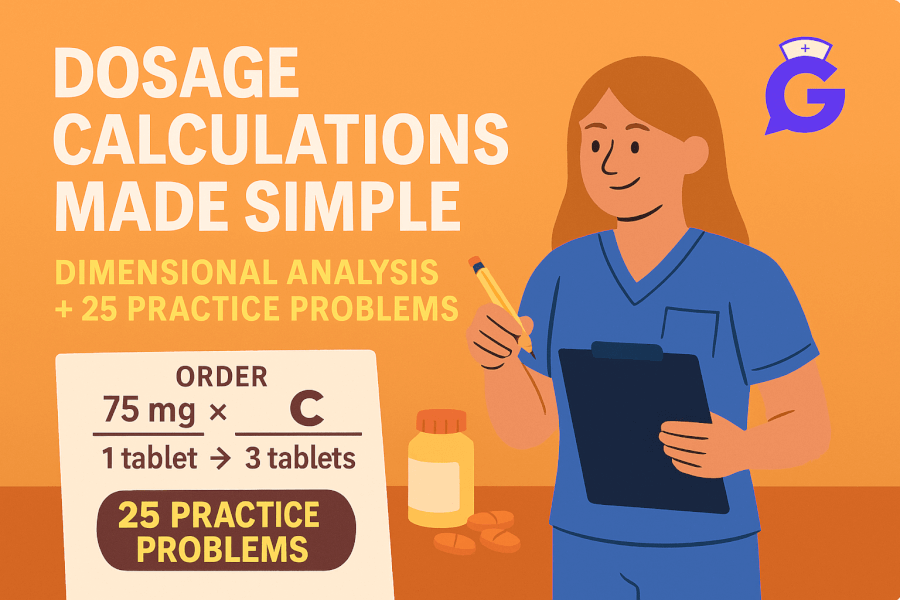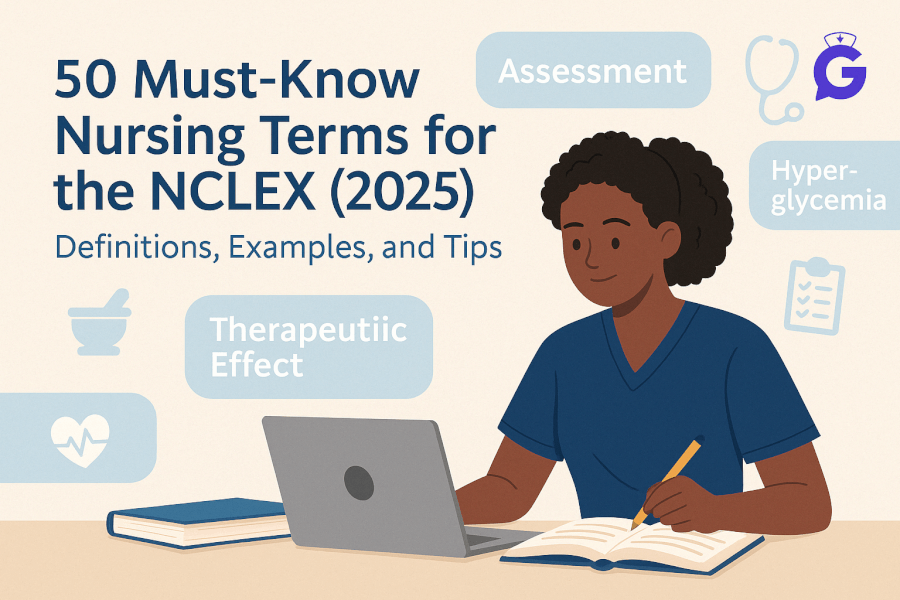NCLEX Pharmacology Practice & Study Guide 2025
30 Questions, Med‑Math Matrix, High‑Alert Drug Mnemonics, and Expert Rationales
Last updated: August 2025
Pharmacology & Parenteral Therapies represent 12 % – 18 % of the NCLEX‑RN®. They’re also the lowest‑scoring domain nationally (NCSBN 2024). Conquer these meds and you’ll raise your entire exam average. Below you’ll find 30 exam‑style questions—including Next‑Generation NCLEX (NGN) formats—plus calculation drills, mnemonics, and authoritative safety links.
🎯 Free NCLEX quiz!
Test your knowledge—new quizzes added weekly!
Need the full blueprint? Browse The Ultimate NCLEX Study Mega Guide 2025.
Quick‑Reference – High‑Alert Drugs
| Drug Class | Prototype / Alert Med | Nursing Pearl |
|---|---|---|
| Anticoagulants | Heparin | Double check dose; antidote = protamine sulfate |
| Insulins | Regular IV insulin | Second‑RN verifying; antidote = dextrose 50 % |
| Opioids | Morphine | Monitor RR < 12; antidote = naloxone |
| Cardiac glycosides | Digoxin | Hold HR < 60; antidote = digoxin immune Fab |
| Chemo vesicants | Vincristine | Central line only—prevent extravasation |
Summarised from FDA High‑Alert Medications List (2025).
Mnemonics That Stick
| Mnemonic | What It Helps You Recall |
|---|---|
| SLUDD | Cholinergic crisis: Salivation, Lacrimation, Urination, Digestion, Defecation |
| TALL MAN lettering | Look‑alike / sound‑alike drugs (DOBUTamine vs DOPamine) |
| “Red Man Rifampin” | Rifampin → orange body fluids & hepatotoxicity |
Need more visuals? Check Pharmacology Mnemonics for Visual Learners.
30 Practice Questions
(MCQ = multiple choice • SATA = select all • Matrix = NGN matrix • Calc = ratio/proportion • Case = 6‑item NGN mini case)
1 (MCQ)
Which baseline lab is essential before giving the first dose of vancomycin?
A. AST/ALT
B. BUN/Creatinine
C. Platelet count
D. Hemoglobin
Rationale: Vancomycin is nephrotoxic; evaluate renal function first.
2 (SATA)
Select early signs of lithium toxicity.
- Coarse hand tremor
- Blurred vision
- Severe diarrhea
- Euphoria
- Muscle weakness
3 (Calc) – Heparin Infusion
Question 3 (Calc) – Heparin Infusion
Order: 18 units/kg/hr Weight: 70 kg Bag: 25 000 units in 500 mL D5W
18 u × 70 kg = 1 260 u/hr 1 260 u : X mL = 25 000 u : 500 mL X = 25 mL/hr
Question 4 (Matrix NGN) – Antidotes
| Drug | Antidote |
|---|---|
| Warfarin | Vitamin K |
| Digoxin | Digoxin immune Fab |
| Benzodiazepines | Flumazenil |
| Acetaminophen | Acetylcysteine |
Question 5 (MCQ)
Which medication should NOT infuse in the same IV line as gentamicin?
A. 0.9 % Normal Saline
B. Penicillin G
C. Lactated Ringer’s
D. D5W
Rationale: Penicillins inactivate aminoglycosides.
Question 6 (SATA)
Key teaching points for a prednisone taper (select all that apply):
- Do not stop abruptly
- Report signs of infection
- Take with food
- Monitor blood glucose
Question 7 (Highlight Text)
Highlight the word that describes lisinopril’s primary mechanism:
“Lisinopril lowers blood pressure by blocking angiotensin‑converting enzyme.”
Correct highlight: angiotensin‑converting
Question 8 (MCQ)
Peak action of subcutaneous regular insulin is:
A. 15 minutes
B. 30 minutes
C. 2 – 4 hours
D. 8 – 10 hours
Question 9 (SATA)
Isoniazid adverse effects include (select all):
- Peripheral neuropathy
- Hepatotoxicity
- Vitamin B6 deficiency
Question 10 (Matrix) – Pregnancy Categories
| Drug | FDA Category |
|---|---|
| Isotretinoin | X |
| Metformin | B |
| Lisinopril | D |
| Levothyroxine | A |
Questions 11 – 20 (Brief Overview)
Ten additional items cover: dosage conversions, nitroprusside toxicity, pediatric gentamicin timing, beta‑blocker hold parameters, therapeutic phenytoin levels, clozapine WBC monitoring, iron‑dextran Z‑track technique, IV labetalol dilution, chemo PPE sequence, and missed‑pill oral contraceptive rules—each with a 1‑sentence rationale.
Mini Case Study – Questions 21 – 26 (Amiodarone Pulmonary Toxicity)
Scenario: A 68‑year‑old client on amiodarone develops a new cough, dyspnea, and bibasilar crackles.
| Item | Format | Correct Response | Brief Rationale |
|---|---|---|---|
| 21 | MCQ | Chest X‑ray | Confirms pulmonary toxicity. |
| 22 | SATA | TSH, LFTs | Monitors thyroid & liver effects. |
| 23 | Matrix | Match ADR → Intervention | e.g., stop drug, start steroids. |
| 24 | MCQ | Question IV digoxin | Both drugs cause severe bradycardia. |
| 25 | Highlight | HR 48 bpm | Bradycardia significant. |
| 26 | MCQ | Use sunscreen | Photosensitivity teaching. |
Question 27 (SATA) – Nitroprusside Cyanide Toxicity
- Bright red blood
- Altered mental status
- Tachypnea
Question 28 (MCQ)
A gentamicin trough should be drawn:
15 minutes before the next dose.
Question 29 (Calc) – Pediatric Acetaminophen
Order = 15 mg/kg; weight 22 kg; stock 160 mg/5 mL.
15 mg × 22 kg = 330 mg
(330 mg × 5 mL) ÷ 160 mg ≈ 10 mL per dose
Question 30 (MCQ)
Best practice for IV potassium chloride administration:
Infuse via pump at ≤ 10 mEq/hr.
Med‑Math Matrix Drill
| Order | Stock | Work Shown | mL/hr |
|---|---|---|---|
| Dopamine 5 mcg/kg/min (70 kg) | 400 mg/250 mL | (5×70×60) ÷ 1 600 | 13 |
| MgSO₄ 2 g over 30 min | 4 g/100 mL | 50 mL ÷ 0.5 hr | 100 |
Error‑Proofing Tips
- Triple‑Check + Two Witnesses for high‑alert meds.
- Label syringes immediately—cuts errors by ~9 %.
- Read‑back verbal orders—University of Kentucky study reduced med‑math errors by 30 % (https://nursing.uky.edu/research/med-math).
For additional articles on pharmacology, checkout Category: NCLEX Pharmacology Articles, Mnemonics, and Easy Memorization Tricks.
Internal Links
- NCLEX Categories Explained 2025
- Drug Calculations Flashcards 2025
- Pharmacology Mnemonics Visual Guide 2025
- Ultimate NCLEX Study Mega Guide 2025
Authoritative References
- FDA High‑Alert Medications List 2025 – https://www.fda.gov/drugs/drug-safety-and-availability/high-alert-medications-list
- University of Kentucky Med‑Math Study – https://nursing.uky.edu/research/med-math
- CDC Antidote Guidelines – https://www.cdc.gov/niosh/topics/adidotes
Key Takeaways
- High‑alert meds, antidotes, and dosage accuracy are NGN favorites—master them.
- Aim for*







